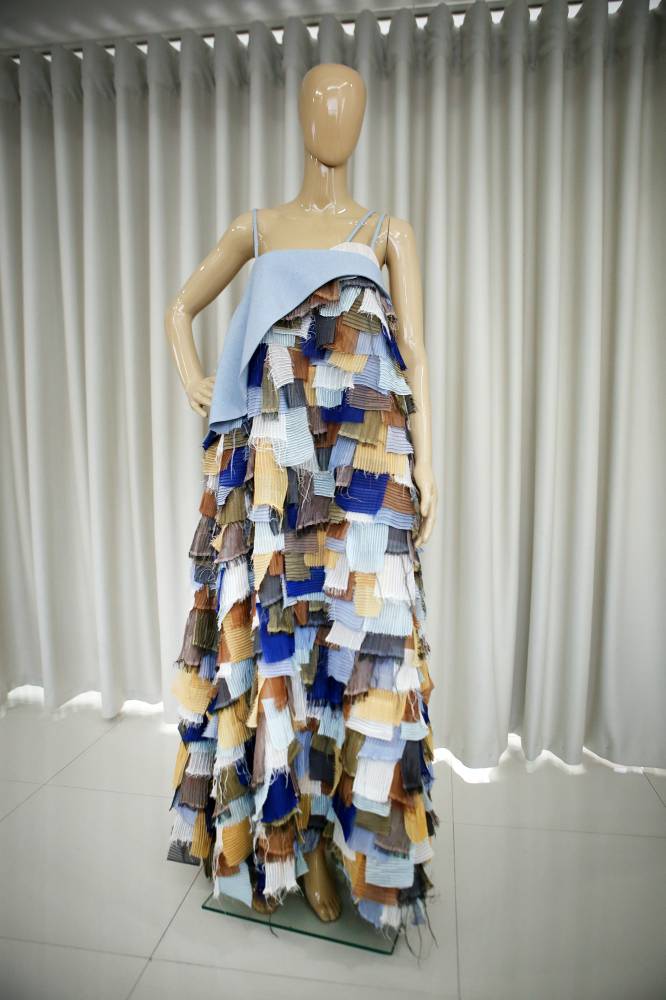Viña Romero’s pieces are even better up close

Lifestyle caught Viña Romero at a busy time, squeezing in a visit at her quaint San Jose del Monte, Bulacan, rooftop atelier. She was in the middle of prepping for a Cebu pop-up and an upcoming show in the United States.
She and three of her contemporaries were invited to showcase their works at Harvard University this month to highlight contemporary Filipino fashion.
“There are artifacts of barong and Maria Clara in Harvard, so they want to connect that to the current scene in the Philippines,” said the designer, dressed in breezy hand-pin-tucked loungewear coords the color of storm clouds despite her own bright and bubbly countenance.

While loath to describe her pieces as Filipiniana, Romero admits that her brand has somehow gained a reputation for creating modern versions of the traditional wear. In fact, many describe her menswear as modern barong, perhaps due to her use of local weaves like piña seda. She has also had weavers from Antique create fabric for her designs—but in normal plaid instead of the usual obviously local patterns. “I want it to be subtle.”
If it were up to her, Romero, who won a scholarship in London from the Inquirer Look of Style contest back in 2014, would rather people take notice of the design first and appreciate the story behind it later.
It is also the reason she has always gravitated toward ready-to-wear (RTW). However, when she was just starting out, RTW pieces were looked down upon. “They would ask why it’s expensive when it’s RTW.”
So she had to do custom work to earn money as she built her team, which became key to her business surviving the pandemic and thriving thereafter.
These days, she still does custom for some clients who connect with her aesthetics. “I can’t really leave doing customization behind because the connection with clients is different. It’s different being a part of a special event in someone’s life, their milestones.”
After the pandemic, Romero and her team started joining pop-ups like ArteFino again. “People were supportive this time, and I feel that was the time we actually touched the right market,” said the De La Salle-College of Saint Benilde graduate, who supplemented her studies by enrolling in the Technical Education and Skills Development Authority (Tesda) course on pattern-making after.
Deceptively simple
“When they buy my piece, they’re buying it because they want it already—not because they want to realize their own vision,” Romero told Lifestyle. “I feel amazed when clients like what I do. It means they saw something in those pieces for them to buy them.
“It’s fully me,” she added. “I feel like I can show my true eye.”
Romero’s designs are deceptively simple, often with a minimalist androgynous silhouette and color palette. But a closer look tells a different tale of complex textures and techniques. “That’s why I needed you to see it in person and I needed to tell you about it myself. Simple is definitely not plain for me.”

Romero likes turning ordinary materials into something unique and extraordinary, like creating textures on regular chiffon. “I like textures. I like the micro details. I like the play on materials.”
This is evident in the wavy path of buttons down a shirt that makes for an interesting design element, albeit a possible nightmare for the inebriated. (No worries, it still fastens like normal since most of the extra buttons are merely ornamental.) The flaps of square fabrics attached to a garment transform both its look and feel. Odd-shaped and oddly placed but deep pockets are delightful additions. French seams ensure a clean finish and a comfortable wear.
Pin-tucked detail
Take also her hand-pin-tucked creation that earned her an invitation to the office of the creative director of Rustan’s during a MaArte Fair. Just three yards of the fabric takes about 20 hours to make. “It’s borne out of necessity. Since I want the fabrics to be unusual, I’ll just find a way to do it myself.”
But discarding scraps from such laborious efforts pained her so much, she decided to use them as accents in other pieces instead. “We spent so much time on that in production. If we just throw it away, it’ll be such a waste,” she said. The resulting patchwork design has since become one of the brand’s bestsellers, even becoming its signature style.

For her spot at Rustan’s department store, she was asked to create a line for men. Despite her inexperience with menswear, the “typical fake-it-till-you-make-it girl” agreed to it.
The shift in the market did not necessarily pose a problem for her, though, with the look of the brand managing to remain true to its design aesthetic, which is essentially Romero’s personal style. After all, she has never been a girly girl. She didn’t really like wearings skirts, and instead constantly raided her dad’s and older brother’s closets growing up.
Personal mix
“My aesthetic is a mix of masculine and feminine. I’ve always liked menswear and womenswear combined,” said Romero. “A lot of my pieces are genderless; we have polos with details that would also fit as menswear. I think that’s what the creative director saw.”
Eventually, female clients also began wandering into and buying from her menswear section. “So, Rustan’s wanted to try my womenswear, as well.”
Romero’s designs are crisp, refreshing, and full of unexpectedly cool details that, in theory, maybe should not work. But in her deft hands, with thoughtful engineering and bold imagination, each charming piece manages to be intensely memorable for its tasteful polish and easy-breezy confidence.

Still, more than her designs, Romero—as a designer and a business owner—wishes to bring into the Philippine fashion conversation the implementation of correct business practices. “We’re far from perfect, but we really aim to for the people we work with to be okay work-wise, quality-of-life-wise. They’re really family.”
When she does mentorship, she also shares her thoughts on how the industry should work, adding that fewer and fewer people are getting into dressmaking because “there’s no money in it.”
“I think that’s the conversation that we want to happen, that it’s not the case. Being a dressmaker is work that you can be truly proud of and you can live off, if compensated properly,” she said, adding that with such work, artisans can be part of something they can feel proud of. INQ

















